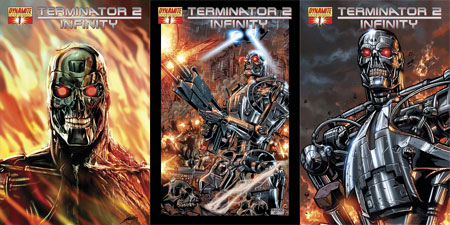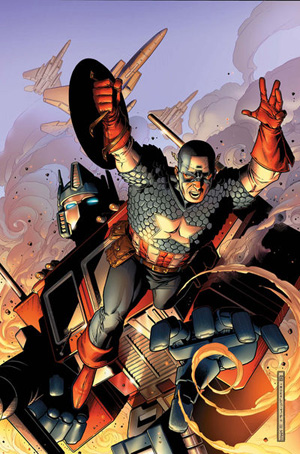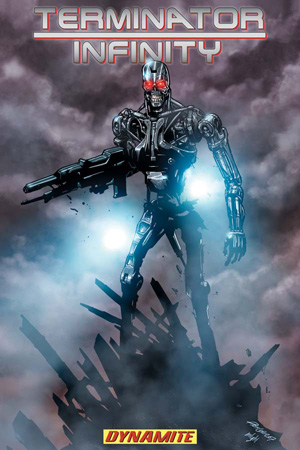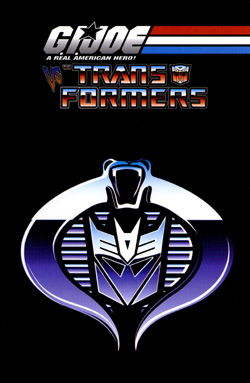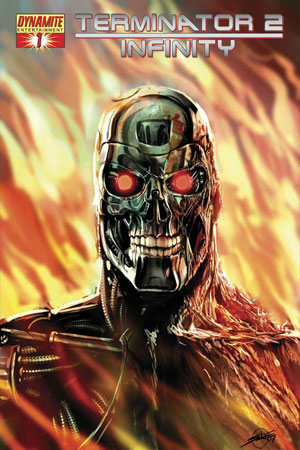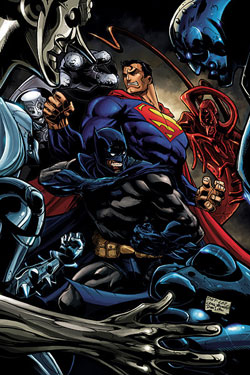|

|
TRANSFORMERS There have been three main publishers of the comic book series bearing the name Transformers based on the toylines of the same name. The first series was produced by Marvel Comics from 1984 to 1991, which ran for 80 issues and also had four spin-off series. This was followed by a second volume entitled Transformers: Generation 2, which ran for 12 issues starting in 1993. The second major series was produced by Dreamwave Productions from 2002 to 2004 with multiple limited series as well, and within multiple story continuities until the company became bankrupt in 2005. The third series is currently being produced by IDW Publishing starting with an issue #0 in October 2005 and a regular series starting in January 2006. There are also several limited series being produced by IDW as well.
In addition to these three main publishers, there have also been several other smaller publishers with varying degrees of success. Please see List of Minor Transformers comics for more information.
The Transformers (Generation 1), Marvel, U.S.
The Transformers comic by Marvel was the first and arguably the best known Transformers comic. Although it was originally intended to be a 4-issue limited series, it expanded into an ongoing series, which ran for 80 issues before being cancelled. The final cover read "80 in a 4 issue limited series". Issues #1-56 were written by Bob Budiansky, with Marvel UK writer Simon Furman taking over for the remainder of the comic. The comic did not attempt to follow the show and some elements and characters were completely absent. Most notably was the absence of characters from season 3 like Ultra Magnus, Springer, Arcee, Metroplex and the Quintessons (with the exception of a stand alone issue which adapted "The Big Broadcast of 2006"). The comic started much the same as the show; a crew crash landing the Ark on Earth in the distant past. They are befriended by Buster Witwicky. His brother Spike eventually joins the cause as Autobot leader when he became the head of commander Fortress Maximus. There occurs a considerable amount of factioning and in fighting in both the Autobots and DeceptICONs. However the series climax occurs when both sides, Autobots and DeceptICONs, form an uneasy peace to defend Cybertron from Unicron. Simon Furman himself says the final issues of the Transformers are his favorite.[citation needed]
Marvel UK
The sister title in the UK, which ran for 332 issues, was weekly and thus spliced in original stories into the continuity of the reprinted US issues, was mostly written by Simon Furman. At the start, it had a more serious science fiction approach. Because of the weekly approach, the UK comic was able to flesh out characters and ideas more. One example of this, in the US comic, The Aerialbots and StuntICONs are first shown having just been built and being given life by the creation Matrix program. In the UK comic, this is more fleshed out. This is a new technology, much more complex than the ConstructICON combination, that Soundwave saw while Scanning Buster Witwicky's brain, the effects of having the Matrix downloaded into his brain for a time. Also, Furman tried to maintain continuity with The Transformers: The Movie, and wrote several stories set in the future after the movie's ending, as well as bringing characters from the future (i.e. Galvatron) into the present-day. Due to his epic and mythological approach, he was highly praised and succeeded Bob Budiansky on the US title at issue 56. The mythic tone continued to influence Furman's work on the Dreamwave and IDW comics.
G.I. Joe and The Transformers, Marvel, U.S., 1986
G.I. Joe and The Transformers
Publisher Marvel Comics
Schedule Monthly
Format Miniseries
Publication dates 1986
Number of issues 4
Main character(s) Autobots, DeceptICONs, G.I. Joe, Cobra
Creative team
Writer(s) Larry Hama
Creator(s) Hasbro
A four-issue limited series that teamed-up the Transformers with the other popular Hasbro property of the 1980s, G.I. Joe. The Joes, the Autobots, and Cobra (after being betrayed by the DeceptICONs) must join forces to stop the DeceptICONs from activating an energy drill device to suck up energy from the Earth's core, which would destroy the planet in the process.
The story was hampered by continuity issues (though the storyline was only referenced in the pages of the Transformers comics, as G.I. Joe writer Larry Hama opted to ignore the mini-series) and the absence of several key characters from both franchises, most notably Cobra Commander, Optimus Prime, and Megatron as the three characters were presumed dead at the time (as well as during events taking place during the series). The series does have some importance towards it though, as the story featured Bumblebee being destroyed by G.I. Joe forces and rebuilt as Goldbug (a plot point that is ignored in the UK comic, where the story was not reprinted until much later in the comic's run and resulted in an alternate story being conceived to transition the character into his "Goldbug" persona).
The Transformers (Generation 1), Marvel, U.S.
Main article: The Transformers (Marvel comic)
The Transformers comic by Marvel was the first and arguably the best known Transformers comic. Although it was originally intended to be a 4-issue limited series, it expanded into an ongoing series, which ran for 80 issues before being cancelled. The final cover read "80 in a 4 issue limited series". Issues #1-56 were written by Bob Budiansky, with Marvel UK writer Simon Furman taking over for the remainder of the comic. The comic did not attempt to follow the show and some elements and characters were completely absent. Most notably was the absence of characters from season 3 like Ultra Magnus, Springer, Arcee, Metroplex and the Quintessons (with the exception of a stand alone issue which adapted "The Big Broadcast of 2006"). The comic started much the same as the show; a crew crash landing the Ark on Earth in the distant past. They are befriended by Buster Witwicky. His brother Spike eventually joins the cause as Autobot leader when he became the head of commander Fortress Maximus. There occurs a considerable amount of factioning and in fighting in both the Autobots and DeceptICONs. However the series climax occurs when both sides, Autobots and DeceptICONs, form an uneasy peace to defend Cybertron from Unicron. Simon Furman himself says the final issues of the Transformers are his favorite.[citation needed]
Marvel UK
The sister title in the UK, which ran for 332 issues, was weekly and thus spliced in original stories into the continuity of the reprinted US issues, was mostly written by Simon Furman. At the start, it had a more serious science fiction approach. Because of the weekly approach, the UK comic was able to flesh out characters and ideas more. One example of this, in the US comic, The Aerialbots and StuntICONs are first shown having just been built and being given life by the creation Matrix program. In the UK comic, this is more fleshed out. This is a new technology, much more complex than the ConstructICON combination, that Soundwave saw while Scanning Buster Witwicky's brain, the effects of having the Matrix downloaded into his brain for a time. Also, Furman tried to maintain continuity with The Transformers: The Movie, and wrote several stories set in the future after the movie's ending, as well as bringing characters from the future (i.e. Galvatron) into the present-day. Due to his epic and mythological approach, he was highly praised and succeeded Bob Budiansky on the US title at issue 56. The mythic tone continued to influence Furman's work on the Dreamwave and IDW comics.
G.I. Joe and The Transformers, Marvel, U.S., 1986
G.I. Joe and The Transformers
Publisher Marvel Comics
Schedule Monthly
Format Miniseries
Publication dates 1986
Number of issues 4
Main character(s) Autobots, DeceptICONs, G.I. Joe, Cobra
Creative team
Writer(s) Larry Hama
Creator(s) Hasbro
A four-issue limited series that teamed-up the Transformers with the other popular Hasbro property of the 1980s, G.I. Joe. The Joes, the Autobots, and Cobra (after being betrayed by the DeceptICONs) must join forces to stop the DeceptICONs from activating an energy drill device to suck up energy from the Earth's core, which would destroy the planet in the process.
The story was hampered by continuity issues (though the storyline was only referenced in the pages of the Transformers comics, as G.I. Joe writer Larry Hama opted to ignore the mini-series) and the absence of several key characters from both franchises, most notably Cobra Commander, Optimus Prime, and Megatron as the three characters were presumed dead at the time (as well as during events taking place during the series). The series does have some importance towards it though, as the story featured Bumblebee being destroyed by G.I. Joe forces and rebuilt as Goldbug (a plot point that is ignored in the UK comic, where the story was not reprinted until much later in the comic's run and resulted in an alternate story being conceived to transition the character into his "Goldbug" persona).
The Transformers: Headmasters, Marvel, U.S., 1987-1988
A four-issue mini-series introducing new characters that were incorporated into the ongoing series (issue #38) at the conclusion of the mini-series. The series introduces the Headmasters, Targetmasters, some of the movie Transformers, Monsterbots, Horrorcons, Technobots and Terrorcons.
The Transformers: The Movie, Marvel, U.S., 1986
A three-issue mini-series adaptation of the feature film, with no continuity ties to the regular comic series. Differences to the animated feature include the original designs for the Autobot Matrix of Leadership and Ultra Magnus' original death at the hand of Scourge and his Sweeps.
Transformers Universe, Marvel, U.S., 1986
A four-issue limited series in the style of Marvel%20UNIVERSE%20'>Marvel UNIVERSE and G.I. Joe: Order of the Battle, featuring lengthy bios of all the Transformers of the period. Most of the text was the same as the tech specs found on the toy boxes, only much more expanded. The first three issues contained all of the first, second and third year Transformers. The fourth issue dealt with characters new to The Transformers: The Movie (1986), including characters that were not made as toys at the time.
Transformers Generation 2, Marvel, U.S., 1993
Main article: Transformers: Generation 2 (comic)
A 12-issue series, the series expanded the original G1 mythos from the small war on Earth and Cybertron to enclose the whole of the Galaxy that was fast being altered into a likeness of Cybertron itself by the Cybertronian Empire, a race of later generation Transformers that evolved while the earthbound Autobots and DeceptICONs were deactivated. The events of this series were actually set in motion with a crossover from the G.I. Joe comic books #138-142, in 1993. Megatron returns in his new tank body to reclaim his leadership from Bludgeon and by the end of the series joins with Optimus Prime to fight against the G2 DeceptICONs and their genetic offshoot, the Swarm. The series ended with an epic battle between the "Generation 1" Transformers, the Cybertronians and the Swarm. It also introduces the Liege Maximo. However, the series was unable to follow through on this because of its cancellation after issue #12.
Note
The Marvel Comics character Death's Head, a character created by Simon Furman, appeared in certain Marvel UK Transformers stories. In the third issue of the All-New Official Handbook of the Marvel%20UNIVERSE%20'>Marvel UNIVERSE A-Z (released on March 22, 2006), the entry for Death's Head's describes his encounters with the Transformers to have taken place in an alternate reality, referred to as Earth-120185, thus separating these stories from existence in standard Marvel%20UNIVERSE%20'>Marvel UNIVERSE continuity. This raises the question of whether or not any of the Marvel Comics Transformers stories take place in the Marvel%20UNIVERSE%20'>Marvel UNIVERSE "proper" (Earth-616), despite such tie-ins as Spider-Man's guest-starring appearance in the original Marvel limited series and Circuit Breaker, a character that originated in the Transformers comics, having a cameo appearance in Marvel's Secret Wars II limited series, which featured nearly every character then existing in the continuity of Earth-616. A case can be made that only the stories that featured Death's Head are separate from standard Marvel continuity, since the character's adventures often involved travel across time and dimensions, not to mention genres; Death's Head also encountered the British science fiction ICON the Doctor from Doctor Who on occasion.
Dreamwave Productions
In early 2002, Dreamwave Productions acquired the Transformers comics license and went on to produce a highly successful return of Transformers to the comic world. They started with a limited series focusing on the Generation 1 characters and a monthly series dedicated to Transformers: Armada. The G1 stories were not bound by the previous Marvel stories nor the animated series. Dreamwave produced a large amount of material, but would go bankrupt and lose the Transformers licence in early 2005.
Generation 1
Transformers: Generation 1
Main article: Transformers: Generation One (Dreamwave)
When they acquired the Transformers licence from Hasbro, Dreamwave]] initially produced a six-issue mini-series, written by Chris Saccarini and drawn by company President Pat Lee, entitled Prime Directive. Despite mixed critical reaction and the late shipping of several issues, the series was a huge sales success. Encouraged by this, Dreamwave produced a second series, this time written by Brad Mick, called War and Peace. When the second series emulated the sales of the first, Dreamwave decided to upgrade the Generation One to an ongoing series focusing on the Earthbound Autobots and DeceptICONs, written by Mick and Adam Patyk, and drawn by Don Figueroa (although Lee and Joe Ng helped draw the first issue ,and issue #4 featured a back-up story drawn by James Raiz). However, Dreamwave's eventual bankruptcy meant that the series would never be concluded past issue #10. It is notable that this is the first piece of Transformers fiction to use the term Generation One in the title. After Dreamwave's bankruptcy, the first two miniseries were redistributed in trade paperback form through IDW Publishing.
Transformers: The War Within
Main article: Transformers: The War Within
After the success of their Generation One series, Dreamwave decided to do a series focusing on the war on Cybertron before the Transformers came to Earth, and recruited Marvel TF writer Simon Furman and former fan artist Don Figueroa for a six-issue series focusing on the rise of Optimus Prime. Later, a second volume appeared entitled The Dark Ages, again written by Furman and drawn by regular Marvel Transformers artist Andrew Wildman. A third volume, called The Age of Wrath, written by Furman and drawn by Joe Ng, was put out and reached issue #3, but due to Dreamwave's bankruptcy it was never completed. The first two series are due for rerelease in trade paperback form by IDW Publishing in March and May of 2007.
Transformers: Micromasters
Main article: Transformers: Micromasters
Micromasters was a four issue mini-series written by Brad Mick and Adam Patyk and drawn by Rob Ruffolo. Set on Cybertron after the disappearance of the Ark, the series focused on the history of the titular Micromasters and the discovery of a mysterious Golden Disk with links to the origins of the Transformers. The series was poorly received by fans.
Transformers: More Than Meets the Eye
An eight issue limited series from 2003 which featured bios of all the Transformers released as toys in the United States (with the exception of several of the Action Masters). The character entries were done in the same style as the 1986 Marvel limited series, Transformers Universe, with page long bios and art of the characters in both their robot and alternate forms. The character bios included expanded information from the original toys' tech specs, as well as new character development from the Dreamwave Transformers continuity. Issues one through seven contain the character bios, while issue number eight contains entries for key Transformer locations, ideas and technology. The first pages of issue one and the last pages of issue eight feature a mini-comic about where all the information presented in the limited series is coming from, and who is accessing it, which was a prequel story to the Beast Wars television series.
Armada/Energon
Transformers: Armada (2002-2003)
This comic series was based on the new Transformers toyline of that year, Transformers: Armada. The continuity, while following elements from the cartoon series of the same name, was wholly its own continuity. Differences included the Mini-Cons' ability to talk in a normal way rather than the beeps and boops from the cartoon series. Also, the resolution to the Armada saga was quite different and involved cross-dimensional travel and several Generation 1 characters. The series ended at issue #18 and was retitled as Transformers: Energon with the following issue. Originally written by Sarracini, Simon Furman came onboard to do a 2-part 'filler' story and ended up as the ongoing writer as a result.
Issues 1-5, written by Chris Saccarini and drawn by James Raiz, would give some background to the original war on Cybertron, detailing how Megatron's campaign started on Cybertron and how the Mini-Cons originally came to Earth, escaping Megatron's grasp. One million years later the arc would intoduce the three main human characters (Rad, Alexis and Carlos) and see both sides battle and gain Mini-Cons for the first time.
Issues 6-7 would see Furman take over the scripting, with Pat Lee on art, detailing the discovery of several more Mini-Con teams on Earth. Issues 8-11, with Guido Guidi taking over on art, would see the discovery of a mysterious Mini-Con monolith that would assemble all the Mini-Cons on a base on the moon, leading the DeceptICONs to attempt a full-scale assault to capture them all. Issues 12-13 would see Megatron construct a superweapon, a powerful laser focusing satellite, in an attempt to destroy the Autobots, as well as capturing enough Mini-Cons to overload Cyclonus' power.
With the series coming to a close and Energon due to take over as the active franchise comic, the next 5 issues were dedicated to the coming of Unicron, with cameo appearances by several G1 characters. With Don Figueroa on art, it detailed the coming of the Heralds of Unicron into the Armada dimension to secure the Mini-Con Matrix and kill all threats. The arc introduced Jetfire and the concept of Powerlinking, as well as having a battle between Armada Megatron and G1 Galvatron, Unicron's chief Herald. The final issue, again drawn by Guidi, served as a bridge between Armada and Energon, detailing Unicron's defeat and Megatron's disappearance.
Transformers: Energon (2003-2004)
Transformers: Energon
Cover for Energon #19
Publisher Dreamwave Productions
Schedule Monthly
Format Monthly
Publication dates 2003-2004
Number of issues 12
Main character(s) Autobots, DeceptICONs
Creative team
Writer(s) Simon Furman
Artist(s) Guido Guidi
Creator(s) Hasbro
The story to Transformers: Energon picks up ten years after events in Armada. The first issue was #19 since Armada was not cancelled but rather retitled. The series was discontinued at issue #30 due to Dreamwave's bankruptcy while being written by Simon Furman and drawn by Guido Guidi.
Launched in December 2003 Energon would retain the numbering system from Armada, as well as the creative team of Furman and Guidi. Issue 19 would pick up where Armada left off, reintroducing the main cast - as well as Unicron and the new threat of the Terrorcons. Issues 20-23 (drawn by Guidi and Joe Ng) saw the introduction of Unicron's Four Horsemen and most of the relevant cast (Prime, Hot Shot, etc) recieving their Energon Powerlinking bodies, as well as establishing that Megatron's Spark was trapped within Unicron. It also saw the Terrorcons journey to Earth and saw the return of the principal human cast, as well as the introduction of Kicker. Issue #24, drawn by James Raiz, focused on the past relationship between Ironhide and Tidal Wave. Issue #25, again drawn by Ng, introduced the OmnICONs and Snow Cat. Issues 26-29, drawn by Alex Milne, saw a full scale Terrorcon attack on Earth, Prime aiding Megatron's rebirth and Starscream's return in his Energon form. Issue #30 saw a confrontation between Megatron and Scorponok - but the bankruptcy of Dreamwave prevented this story from being finished.
Transformers Armada: More Than Meets the Eye
In 2004 Dreamwave released a three issue version of the More Than Meets The Eye series featuring all the Transformers: Armada characters released as toys in the United States. The layout was similar to the G1 series from 2003, and included separate character bios for the MinICONs as well as for the other Transformers. The first pages of issue one and the last pages of issue three feature a mini-comic of the human character Alexis studying the history of the Transformers. The comic seems to be set sometime between the events of the Transformers: Armada and Transformers: Energon Dreamwave comics. Before Dreamwave's bankruptcy, an Energon edition of More Than Meets The Eye was also planned.
Transformers/G.I. Joe
With the success of Transformers and the same with Devil's Due Productions's revival of G.I. Joe, it did not take long for fans of both properties to speculate on a cross-over and their wishes were answered. Dreamwave and Devil's Due each produced their own six-issue mini-series and continuity. For Dreamwave, rather than follow the previous efforts of Marvel Comics, the story is set in an alternate continuity, and was written by John Ney Reiber and drawn by Jae Lee. Here Cobra had discovered and awakened the DeceptICONs, reformatting their alt modes into 1940s era war vehicles and weapons. The two evil forces cnquered much of Europe in a alternate version of World War 2. The G.I. Joe Team, here a group of American volunteers, find the Autobots who aid them in stopping both Cobra and DeceptICONs.
A second volume was produced, written by Brad Mick and drawn by Pat Lee. Dreamwave managed to release one issue before their financial troubles put a halt to their operations. The story would have followed G.I. Joe and Transformers in the present time and the connection to the first volume's story explained.
Transformers Summer Special
The Transformers Summer Special was a one-shot produced in the Summer of 2004 that featured stories from Generation 1, Energon, Robots in Disguise, and Beast Wars. The later two were put to a vote by fans, and the winner (Beast Wars) was to be the next Transformers comic series. The Summer Special was to be an annual mini-series but due to Dreamwave's bankruptcy only one issue was published.
The Generation 1 segment, written by Brad Mick and Adam Patyk and drawn by Pat Lee and Joe Ng, focused on the Predacons. The Predacons were once warlords on Cybertron who were cast into exile in space. Settling on Planet Beest, (a homage to the Battle Beasts toyline), the Predacons sank into a feral state, and lived as inhabitants of that world for untold years, until Megatron arrived. Having been jettisoned into space by Starscream and restored from the brink of death by Wreck-Gar, Megatron now had his sights set on reclaiming the DeceptICON leadership, and required the Predacons to bolster his army. Abandoning his personal weaponry, Megatron pursued Razorclaw through the jungle and soundly defeated him. Subsequently, he re-engineered the Predacons to give them the ability to combine into Predaking. This would later impact the ongoing Generation 1 comic when Megatron brought them to Cybertron to help defeat Shockwave and later to Earth.
There were three other stories, including a Transformers: Energon tale written by Simon Furman and drawn by James Raiz. The tale focused on Slugslinger, SharktICON and Snow Cat, who had been defeated in an assault by Omega Supreme, telling lies to Megatron in order to excuse their failure. Megatron eventually appoints Slugslinger as his lieutenant, as his lie was the most impressive.
The other two, both written by Brad Mick and Adam Patyk, focused around Beast Wars and Transformers: Robots in Disguise. The RiD tale, drawn by Rob Ruffolo, focused on Scourge and Sky-Byte stealing a nuclear reactor, while Optimus Prime and Ultra Magnus learn the value of teamwork to stop them. The Beast Wars tale, drawn by Don Figueroa, focused on Rattrap reminiscing on a time when he was attacked by Dinobot 2, only to be saved by a trio of mysterious Maximals.
Beast Wars
In the Summer Special a competition was run to choose whether the next Dreamwave Transformers series would be Beast Wars or Transformers: Robots in Disguise. Beast Wars won, and the War Within team of Simon Furman and Don Figueroa were slated as the creative team. However, Dreamwave's bankruptcy would mean that no issues were ever published, although Images and issue synopses have appeared on the Internet . Ironically Furman and Figueroa would eventually become the creative team on IDW Publishing's eventual Beast Wars series.
IDW Publishing
After Dreamwave's collapse in the winter of 2004, Hasbro awarded the Transformers comic license to IDW Publishing the following the spring with plans to relaunch the property. Two miniseries were initially planned: one featuring the Generation One characters and the other focusing on the Beast Wars. The success of these has led to several other projects as listed below. Long-time Transformers writer, Simon Furman was brought aboard and given the creative reigns over both series, as well as their spinoffs. He took the opportunity to reboot the Generation One universe, going in a new direction from any previous incarnation, though retaining key elements such as character personalities and paint schemes.
The Transformers: Infiltration
Main article: The Transformers: Infiltration
The Transformers: Infiltration premiered in October 2005 with issue #0 and properly launched with issue #1 in January, 2006. Simon Furman wrote and E. J. Su penciled a new six-issue re-imagining of the Transformers arriving on Earth. The story concluded in July to be continued by The Transformers: Escalation (see below). A trade paperback of Infiltration has since been released.
A recent press release indicated that The Transformers: Infiltration #0 set a record in the five-year history of IDW Publishing, surpassing over 100,000 copies in initial pre-orders.
The Transformers: Stormbringer
Main article: The Transformers: Stormbringer
Stormbringer debuted in July 2006 and is set during the same time frame as Infiltration (in the first issue, Optimus Prime receives Ironhide's message from Infiltration). The setting is far from Earth, and the Transformers are scattered across the universe since Cybertron had been made uninhabitable by war. The series' main villain is Thunderwing, and key protagonists include Jetfire and the Technobots. The mini-series was promoted with the tagline "No Humans on Cybertron!", referring to many fans' discontent over the human cast of Infiltration. The four-issue series is written by Simon Furman and drawn by Don Figueroa. The two had previously collaborated on several projects for Dreamwave, as well as IDW's own Beast Wars: The Gathering.
Curiously, the first issue of Stormbringer contains the number '7' inside, continuing from Infiltration' numbering, meaning that despite being sold as mini-series, the G1 comics by Furman are Essentially being considered by IDW as a single comic series.
The Transformers: Escalation
Main article: The Transformers: Escalation
The sequel series to Infiltration. Escalation (again written by Furman and drawn by Su) focuses on the Machination, an organization dedicated to capturing Transformer technology, and Optimus Prime attempting to stop Megatron's attempts to bring about a war which will decimate humanity. The story began in November of 2006 and concludes in April 2007. The story will be followed by The Transformers: Devastation (see below).
The Transformers: Devastation
Main article: The Transformers: Devastation
Devastation will pick up where Escalation leaves off. Little is known at this point, save that it will comprise the same creative team of Furman and Su. IDW editor-in-chief Chris Ryall has indicated the series will premiere in the autumn of 2007 . According to writer Simon Furman, the follow-up arc will be called The Transformers: Revalation and will feature elements introduced in the Spotlight issue on Galvatron.
The Transformers: Spotlight
Main article: The Transformers: Spotlight
The Spotlight series is also set in IDW's new Generation One universe and consists of one-shots focusing on characters who have not yet appeared in IDW's main series. However, their tales will have repercussions on the main story, setting up future events or explaining the history behinds events already seen. All issues have so far been written by Simon Furman, but that won't be the case forever. Released Spotlights have included Shockwave, Nightbeat, Hot Rod, Sixshot, Ultra Magnus and Soundwave. Further issues have been announced, including one in April 2007 for Kup (which will be scripted by Nick Roche), Galvatron in July, and Optimus Prime in September. The latter two will again be written by Simon Furman.
The Transformers: Megatron: Origin
Main article: The Transformers: Megatron: Origin
This upcoming 4-issue mini-series will be written by Eric Holmes and drawn by Alex Milne. Megatron: Origin will detail the rise of Megatron to power, the origin of the DeceptICONs and the beginning of the Civil War on Cybertron. The series is due to begin in May, with alternate covers by Milne and Marcelo Matere.
New Avengers/Transformers
Main article: New Avengers/Transformers
A crossover with the original holders of the Transformers license, Marvel Comics, this series will take place in both Marvel's ongoing continuity, (pre-Civil War), and IDW's G1 continuity, in between Infiltration and Escalation. The 4-issue series will be written by Stuart Moore and drawn by Tyler Kirkman, and is due to start in July. Captain America, Iron Man, Wolverine, and Spider-Man have been confirmed to appear, as well as many of the Transformers cast of Escalation.
Other series
In addition to their main Generation 1 continuity, IDW have also created as variety of material based on the various Transformers universes, both the original animated series as well as original material and the upcoming live-action movie.
Beast Wars
Main article: Beast Wars: The Gathering
Beast Wars: The Gathering was released in 2006 as a four-issue series written by the Stormbringer team of Furman and Figueroa. The series takes place after season 2 of the Beast Wars animated series and features characters that had toys produced but were not featured in the cartoon. The trade paperback was released in August 2006. A second series called The Ascending is due in August 2007. , with a series of More Than Meets The Eye-style profile books also due in August. . The continuity is separate from the new IDW Generation One universe, and is set in-continuity with the original show.
The Transformers: Generations
Main article: The Transformers: Generations
Generations is a series that reprints key or best-of issues from the Marvel series but with new cover art. Issues containing Marvel characters (such as the original issue #3, which featured Spider-Man) could not be reprinted for this series. Also, using any Dreamwave material was not possible at this time due to legal ramifications from their bankruptcy. . After issue #12 is released in March 2007 the series will reprint the Marvel UK arc Target: 2006 in condensed form, beginning in April.
The Transformers: Evolutions
Main article: The Transformers: Evolutions
Evolutions is a title that features stand-alone, out-of-continuity tales from rotating creative teams. Chuck Dixon wrote the first four-part series "Hearts of Steel" - revolving around steam-powered Transformers on Earth in the 19th Century - with art by former Dreamwave artist Guido Guidi. It premiered in July, 2006. At its conclusion, the publishers warned that they needed to be conservative with alternate-reality stories, because both they and Hasbro didn't want to make things too confusing before the 2007 movie is released . For this reason, the series is on hold until after the movie premieres.
Transformers: The Animated Movie
Main article: Transformers: The Animated Movie
Transformers: The Animated Movie is a four-issue comic book adaptation of the classic 1986 Transformers movie in correspondence with the 20th anniversary of the film's release. The first issue was released in October 2006 and the run coincided with the release of the Sony/BMG 20th Anniversary The Transformers: The Movie Special Edition DVD, released on November 7, 2006. The adaptation is written by former Marvel Transformers writer, Bob Budiansky and illustrated by Don Figueroa. The series included scenes and characters in the comic that didn't make it into the movie. .
Transformers: The Movie Prequel
Main article: Transformers: The Movie Prequel
The Movie Prequel is a four-issue mini-series which serves as a prequel to the events of the 2007 Transformers movie. It will be written by Chris Ryall and Simon Furman, with art by Don Figueroa.
The first issue was delayed, being released on March 6th 2007 due to a printing error.
Transformers: The Movie Adaptation
IDW have also indicated that they will be doing a four issue adaptation of the 2007 Movie running weekly in June . Alex Milne will do art for the adaptation itself.
The Transformers Magazine
IDW have revealed that they will also be doing a magazine in the style of the original Marvel UK Transformers comics, reprinting material from the Marvel, Dreamwave and new IDW comics. As with Generations, there will be an original cover. The first issue is out in June 2007.
This article uses material from Wikipedia and is licensed under the GNU Free Documentation License.All material is compiled from numerous sources and may not be accurate. Dynamic Forces, Inc and all of its subsidiaries cannot guarantee the validity of the content. |
 |





